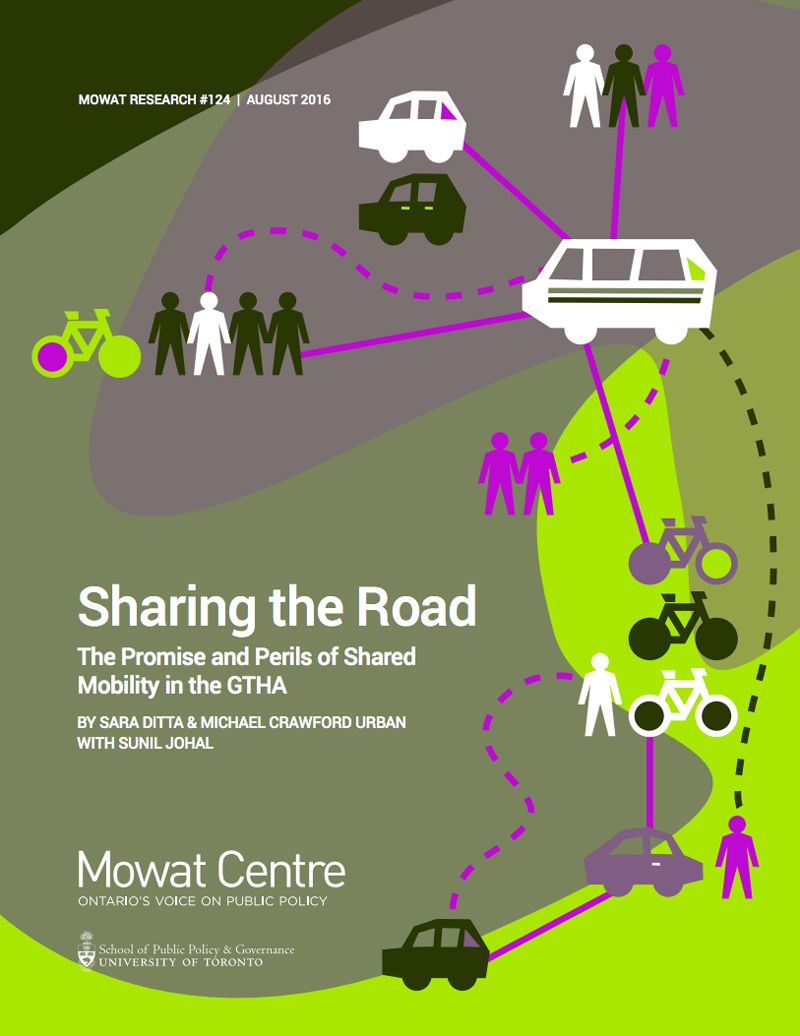August 19, 2016
The Promise and Perils of Shared Mobility in the GTHA
This report makes a series of recommendations for building a robust and flexible transportation system that can effectively respond to the emergence of “shared mobility” in the Greater Toronto and Hamilton Area.
Shared mobility offers significant opportunity through improved convenience, cost-effectiveness and increased options for travel. To successfully leverage this opportunity, however, policymakers will have to be proactive, innovative, flexible and collaborative in responding to emerging trends within the sharing economy and overcoming any challenges that may emerge.
Executive Summary
The Greater Toronto and Hamilton Area’s (GTHA) transportation system faces significant challenges related to congestion, long commute times and limited integration across the region. At the same time, global trends and emerging technologies are disrupting traditional modes of mobility. The arrival of the “sharing economy” – in which online marketplaces allow consumers to forgo ownership and purchase real-time access to specific products or services instead – has governments around the world scrambling to respond effectively. For decision-makers, these developments present major opportunities and challenges for improving the region’s transportation system.
For consumers, “shared mobility” – which describes the innovations in mobility enabled by the sharing economy – offers the possibility of significant benefits, including more convenient and less costly transportation options. More broadly, these emerging business models have the potential to limit greenhouse gas emissions, reduce congestion and fill gaps in the GTHA’s transportation system. Alongside these potential benefits come challenges, however, as shared mobility stands to disrupt many existing services and traditional jobs associated with them within the transportation system, as well as threatening to undermine policies designed to support equity and accessibility.
Consequently, policymakers should adopt approaches that are proactive, flexible, innovative and collaborative to ensure that the benefits of shared mobility are secured while avoiding its potential pitfalls. More specifically, transportation strategies in the GTHA must incorporate shared mobility services by improving support for multi-modal transportation – the use of multiple modes of transportation (e.g. bike and subway) as parts of a single trip – and encouraging more public-private partnerships between transportation providers. Furthermore, several key issues must be addressed, ranging from specific concerns about taxation to issues that are broader in scope such as the inclusiveness of our transportation system.
Continue Reading
This report offers six broad recommendations for building a robust and flexible system that can effectively respond to the emergence of shared mobility:
1] Expedite regulatory reform
2] Prioritize partnerships
3] Ensure open data, technological neutrality and interoperability
4] Develop leadership and coordination mechanisms
5] Re-align incentives to promote shared mobility
6] Embrace emerging technologies
Notably, this report recommends that the Government of Ontario lead and develop a flexible and responsive regulatory framework. This framework should aim to integrate shared mobility into the GTHA’s transportation system by using it to better enable multi-modal travel. Specific recommendations range from calling for all GTHA municipalities to quickly develop frameworks for regulating ride-sourcing services such as UberX – something that has already been done in Toronto but is at various stages in other municipalities – to launching more partnerships between public transit and private shared mobility providers.
Overall, if it is integrated into the transportation system appropriately, shared mobility offers the GTHA a number of significant positive opportunities that policymakers should seize. However, doing so will require a willingness to explore new ways of doing business. As part of these efforts, policymakers will need to more fully embrace the ideal of a “customer-first transportation system,” as laid out in The Big Move, the region’s transportation plan.
Clearly, the arrival of Uber in the GTHA and in cities around the world has demonstrated the risks that taking a passive approach to innovation can create for policymakers. The GTHA’s transportation system cannot afford to repeat the past two years of regulatory uncertainty and unpredictability. Policymakers in today’s age need to proactively seize the initiative and work with foresight and vision toward solutions that harness new technological innovations for the advancement of the transportation system’s overarching objectives. This final lesson is particularly important given the similar, but more serious and far-reaching, challenges associated with the imminent arrival of automated vehicles and the next wave of transportation innovation.
Authors
Sara Ditta
Michael Crawford Urban
with Sunil Johal
Release Date
August 19, 2016
ISBN
978-1-77259-020-3
Mowat Research
No. 124








